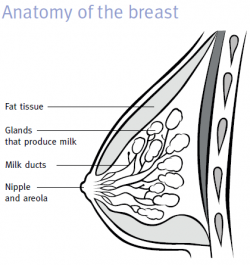The anatomy of the breast – a mother’s need-to-know
In order to understand breastfeeding, correct practices and some of the common issues that may come our way, we should first understand the basic anatomy of the female breasts. The main structures of the breast include:
- The nipple and the areola – primarily designed to allow nursing, nipples usually grow larger during pregnancy, while areolas get darker. Some experts believe this is Mother Nature’s way of making it easier for the baby to find their way to the breast.
- Mammary tissue – this tissue contains many glands that produce milk and excrete it into milk ducts that allow the milk to flow all the way to the nipple. Milk ducts are surrounded by muscle cells that contract during nursing and help maintain the milk flow.
- Connective tissue and fat – these tissues provide support and protection to the more delicate milk-secreting parts of the breast.
- Blood vessels, lymphatic vessels and nerves.
During pregnancy and after the delivery, your breasts go through extensive changes that are all orchestrated by four hormones secreted in your body: estrogen, progesterone, prolactin and oxytocin.
Estrogen and progesterone are released by the placenta during pregnancy and their role is to prepare the breasts for milk production. Under their influence, your breasts will start creating more milk ducts, but milk production will not be starting just yet. Once your baby has been delivered and the placenta is removed, levels of these hormones in your body drop, giving a signal that milk production can begin.
After your baby is delivered, the first milk your breasts will secrete is called colostrum. This thick and clear fluid is filled with antibodies which will protect your baby so that their immune system has enough time to develop and strengthen. A few days later, the real milk will start being produced and you will notice that your breasts have become swollen, heavy and warm to the touch. This is normal and it will disappear in a couple of weeks.
Once estrogen and progesterone have done their part, prolactin and oxytocin take over. Prolactin is encourages your body to produce milk – every time you nurse your baby or express milk, prolactin levels in your body increase, giving your breasts the needed signal to produce more milk. On the other hand, oxytocin is there to make sure that the produced milk is released from the breasts – therefore, causing the letdown reflex when the milk is squeezed out of its reservoirs and pumped into the milk ducts. The initial signal for the letdown reflex is the sucking sensation your baby creates when trying to nurse.
Milk production in your body is regulated in a fascinating way with some help from a protein called Feedback Inhibitor of Lactation. This protein reduces the milk production once the breast is full –therefore, milk is produced based on the supply-demand mechanism. If your baby stops nursing or you skip a feeding, the level of this protein in your breast increases, causing reduced milk production. The same goes the other way around – the more your baby nurses, the more milk your body creates. That is why it is so important to nurse as often as needed, so that your milk supply is maintained at a high, optimal level.


